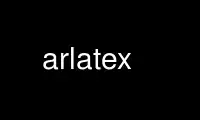
This is the command arlatex that can be run in the OnWorks free hosting provider using one of our multiple free online workstations such as Ubuntu Online, Fedora Online, Windows online emulator or MAC OS online emulator
PROGRAM:
NAME
arlatex - archive a number of ancillary LaTeX files into a master .tex file
SYNOPSIS
arlatex [--outfile=filename.tex] --document=filename.tex filename ...
arlatex --version
arlatex --help
DESCRIPTION
arlatex is an archiving program like shar, tar, zip, etc. Unlike those other archivers,
however, arlatex is designed specifically for use with LaTeX. arlatex takes the name of a
master .tex file and a number of ancillary files used by that master file (e.g., .tex,
.sty, .cls, and .eps files). From these, arlatex outputs a single file that, when it's
run through latex, both regenerates the ancillary files and compiles the document into a
.dvi file.
arlatex has a few advantages over other archiving programs:
· The .tex files produced by arlatex are in a plain-text format. They are therefore
perfectly portable and trivial to e-mail to colleagues.
· arlatex needs only LaTeX to run. There is no dependence on any external tools.
· There is no explicit extraction step. As the generated document is run through latex,
it extracts the ancillary files and builds the document in the same step. The user
running latex may not even notice that additional files are being produced.
arlatex works by writing a number of "\begin{filecontents*}" ... "\end{filecontents*}"
blocks to the output file, followed by the contents of the master file. (In fact, any
LaTeX comments at the beginning of the master file are hoisted to the top of the generated
file. This enables the author to draw attention, if so desired, to the fact that
ancillary files will be generated.) The "filecontents*" environment, part of standard
LaTeX2e, writes its contents verbatim to a specified file.
OPTIONS
--version
Output the arlatex script's version number.
--help
Output brief arlatex usage information.
--document=.tex file
Specify the master document. The output from arlatex is this file with all of the
other files named on the command line prepended to it. Note that "--document" is a
mandatory parameter; arlatex will abort with an error message if "--document" is not
specified.
--outfile=.tex file
Specify the output file. The output file looks just like the master document, but
with a number of "filecontents*" environments preceding the "\documentclass" line. If
"--outfile" is not specified, output will be written to the standard output device.
EXAMPLES
Suppose you have a paper called paper.tex that loads a custom package with
"\usepackage{mypackage}". You want to submit the paper to a conference, but you want to
be absolutely certain that mypackage.sty doesn't get lost as your paper is shuttled from
person to person. Here's how arlatex can be of use:
arlatex --document=paper.tex mypackage.sty --outfile=paper-submit.tex
When paper-submit.tex is processed with latex, it builds just like the original paper.tex,
except that it additionally creates a mypackage.sty in the current directory:
This is TeX, Version 3.14159 (Web2C 7.3.1)
(paper-submit.tex
LaTeX2e <1999/12/01> patch level 1
Babel <v3.6Z> and hyphenation patterns for american, french, german,
ngerman, italian, nohyphenation, loaded.
LaTeX Warning: Writing file `./mypackage.sty'.
(/usr/share/texmf/tex/latex/base/article.cls
Document Class: article 1999/09/10 v1.4a Standard LaTeX document class
(/usr/share/texmf/tex/latex/base/size12.clo)) (mypackage.sty)
.
.
.
As another example, here's how you could bundle together all of the files needed to build
a large document for longevity:
arlatex --document=thesis.tex abstract.tex introduction.tex
background.tex approach.tex experiments.tex relatedwork.tex
conclusions.tex before.eps after.eps fast.eps slow.eps
podunkUthesis.cls --outfile=thesis-all.tex
As the number of files to archive together increases it becomes more cumbersome to run
arlatex manually. Fortunately, using arlatex with bundledoc is straightforward.
bundledoc finds all of the files needed to build the document, and arlatex combines them
into a single file. The following are examples of the "bundle:" line you might use in a
bundledoc configuration file:
Unix:
bundle: (arlatex --document=$BDBASE.tex $BDINPUTS \
--outfile=$BDBASE-all.tex)
Windows:
bundle: arlatex --document=%BDBASE%.tex %BDINPUTS% \
--outfile=%BDBASE%-all.tex
See the bundledoc documentation for more information.
CAVEATS
arlatex makes use of LaTeX2e's "filecontents*" environment. "filecontents*" refuses to
overwrite an existing file. However, it also refuses to create a file that exists
anywhere that LaTeX can find it. That is, if the user running latex on an
arlatex-generated .tex file already has a /usr/share/texmf/tex/latex/whatever/whatever.sty
file then "filecontents*" will refuse to create a whatever.sty file, even in a different
directory.
Use arlatex online using onworks.net services
